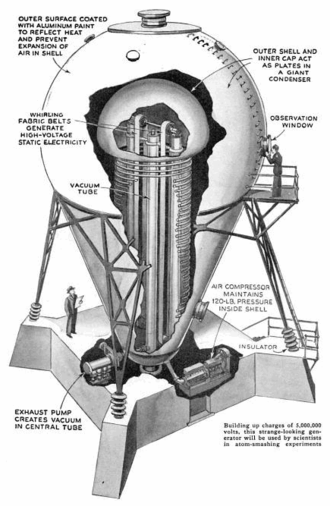Westinghouse Atom Smasher
| Westinghouse Atom Smasher | |
|---|---|
|
The Atom Smasher on May 9, 2010, before the 2015 demolition | |
| General information | |
| Address | F Avenue & West |
| Town or city | Forest Hills, Pennsylvania |
| Coordinates | 40°24′39″N 79°50′35″W / 40.4108661°N 79.8430295°W |
| Opened | 1937[1] |
| Closed | 1958[2] |
| Demolished | January 20, 2015 |
| Owner | Gary Silversmith[3] |
| Designated | August 28, 2010 [1] |
Westinghouse Atom Smasher was a 5 MeV Van de Graaff electrostatic nuclear accelerator operated by the Westinghouse Electric company at their research center in Forest Hills, Pennsylvania. It was instrumental in the development in practical applications of nuclear science for energy production[4][5] It was the first industrial Van de Graaff generator in the world,[1] and marked the beginning of nuclear research for civilian applications.[6] Built in 1937, it was a 65 feet (20 m) tall pear-shaped tower.[1][2] It went dormant in 1958.[2] In 1985, it was named an Electrical Engineering Milestone by the Institute of Electrical and Electronics Engineers.[7]
Preservation efforts
In 2012 the property surrounding the atom smasher was purchased by Gary Silversmith, a developer who intended to build apartments, and expressed an interest in saving the smasher.[3] In 2013, the Young Preservationists Association of Pittsburgh named it was one of the city’s top 10 preservation opportunities.[3] During 2013, plans had been discussed of the Woodland Hills School District establishing a STEM educational facility with the atom smasher as the centerpiece, but the $4 to $5 million cost was prohibitive and the project never moved forward.[3]
By 2015, the structure was in significant disrepair and was dislodged from its supports, due to vandalism and age.[3] On January 20, 2015, Silversmith had the atom smasher removed from its supports and laid on its side.[3] Workers laid bricks to brace the fall, and tipped it over.[2] The demolition was decried by the Pittsburgh History & Landmarks Foundation and the mayor of Forest Hills.[3] Barry Cassidy, a friend of the developer who had worked since 2013 to secure grants to restore the smasher, resigned from the project after the demolition.[2][3] In an email to the Pittsburgh Post-Gazette, Silversmith pronounced his continuing commitment to refurbishing and restoring the atom smasher, saying "The iconic Atom Smasher bulb survives." [3]
How it worked


In a Van de Graaff generator, invented in 1929 by Robert J. Van de Graaff, an endless fabric belt carries electric charge into a round hollow electrode, developing high voltages. In the Westinghouse machine, two belts traveled up a 47 ft. shaft to a mushroom-shaped electrode inside the dome[8] (see cutaway drawing below). The high voltage was used to accelerate subatomic particles to high speeds as they traveled down an evacuated 47 ft. accelerator tube parallel to the belts into the base of the machine, where they struck a target to create nuclear reactions. The energy of the particles was equal to the voltage on the machine's electrode. The maximum voltage that a Van de Graaff generator could produce was limited by leakage of the charge off the electrode due to corona discharge and arcing. At atmospheric pressure, a Van de Graaff machine was limited to around 1 megavolt. So the machine was installed inside a pear-shaped 65 ft. tall, 30 ft. diameter air tank which was pressurized during use to 120 pounds per square inch.[8] The high pressure air improved insulation, reducing charge leakage, allowing the machine to achieve a voltage of 5 megavolts, although it was originally hoped to reach 10 megavolts.
See also
![]() Media related to Westinghouse Atom Smasher at Wikimedia Commons
Media related to Westinghouse Atom Smasher at Wikimedia Commons
References
- 1 2 3 4 "PHMC Historical Markers Search" (Searchable database). Pennsylvania Historical and Museum Commission. Commonwealth of Pennsylvania. Retrieved 2015-02-15.
- 1 2 3 4 5 O'Neill, Brian (January 25, 2015). "Brian O'Neill: With Forest Hills atom smasher's fall, part of history tumbles". Pittsburgh Post-Gazette.
- 1 2 3 4 5 6 7 8 9 Harkins, Jill (January 21, 2015). "Atom smasher in Forest Hills torn down; restoration promised". Pittsburgh Post-Gazette.
- ↑ "Van de Graaff particle accelerator, Westinghouse Electric and Manufacturing Co., Pittsburgh, PA, August 7, 1945.". Explore PA History. WITF-TV. Retrieved February 19, 2015.
- ↑ "Westinghouse Electric Corporation [Science and Invention] Historical Marker". Explore PA History. WITF-TV. Retrieved February 19, 2015.
- ↑ Toker, Franklin (2009). Pittsburgh: A New Portrait. p. 470.
- ↑ Atom Smasher, 1937 "Milestones:Westinghouse Atom Smasher, 1937" Check
|url=value (help). Institute of Electrical and Electronics Engineers. 2013. Retrieved February 25, 2015. - 1 2 "Huge generator to smash atoms". Popular Science. Popular Science Publishing Co. 131 (1): 35. July 1937. Retrieved April 28, 2015.
